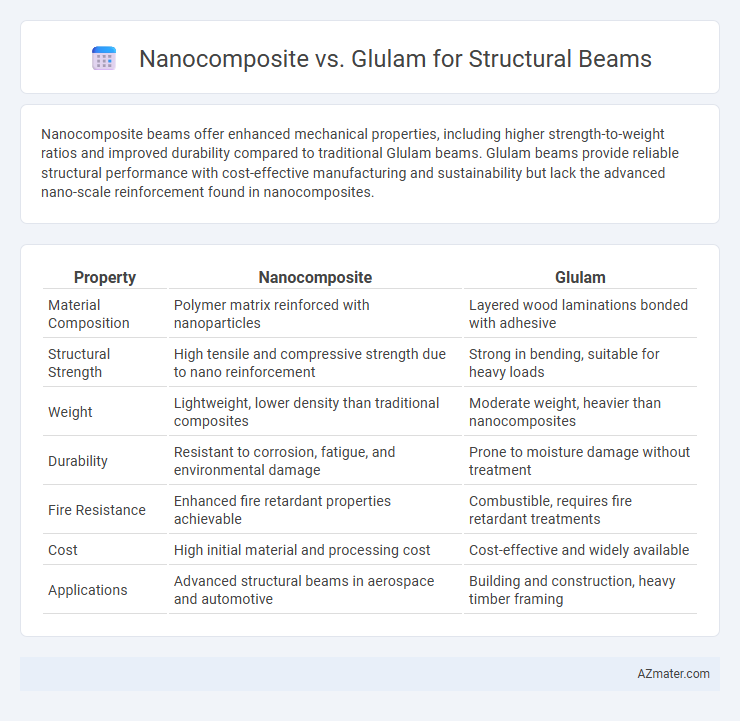Nanocomposite beams offer enhanced mechanical properties, including higher strength-to-weight ratios and improved durability compared to traditional Glulam beams. Glulam beams provide reliable structural performance with cost-effective manufacturing and sustainability but lack the advanced nano-scale reinforcement found in nanocomposites.
Table of Comparison
| Property | Nanocomposite | Glulam |
|---|---|---|
| Material Composition | Polymer matrix reinforced with nanoparticles | Layered wood laminations bonded with adhesive |
| Structural Strength | High tensile and compressive strength due to nano reinforcement | Strong in bending, suitable for heavy loads |
| Weight | Lightweight, lower density than traditional composites | Moderate weight, heavier than nanocomposites |
| Durability | Resistant to corrosion, fatigue, and environmental damage | Prone to moisture damage without treatment |
| Fire Resistance | Enhanced fire retardant properties achievable | Combustible, requires fire retardant treatments |
| Cost | High initial material and processing cost | Cost-effective and widely available |
| Applications | Advanced structural beams in aerospace and automotive | Building and construction, heavy timber framing |
Introduction to Structural Beam Materials
Nanocomposite materials for structural beams offer enhanced mechanical properties, including higher strength-to-weight ratios and improved durability compared to traditional materials. Glulam, or glued laminated timber, utilizes layers of wood bonded with adhesives, providing excellent load-bearing capacity and versatility in architectural design. Both materials are increasingly important in modern construction, with nanocomposites pushing the boundaries of material science and glulam promoting sustainable and renewable building practices.
Overview of Nanocomposite Beams
Nanocomposite beams integrate nanoscale materials such as carbon nanotubes or graphene within traditional composite matrices, enhancing mechanical properties like strength, stiffness, and durability compared to conventional Glulam beams. These nano-reinforcements improve load-bearing capacity, resistance to environmental degradation, and reduce weight without sacrificing structural integrity. The advanced material characteristics of nanocomposite beams make them a promising alternative for high-performance structural applications requiring enhanced sustainability and longevity.
Understanding Glulam: Engineered Timber Beams
Glulam, or glued laminated timber, consists of multiple layers of dimensional lumber bonded together with durable adhesives to create strong, versatile structural beams. Engineered for enhanced load-bearing capacity and dimensional stability, glulam beams are widely used in construction for their ability to span long distances without heavy supports. Compared to nanocomposite beams, glulam offers a sustainable timber alternative with predictable performance, ease of fabrication, and resistance to warping and splitting under load.
Mechanical Properties Comparison
Nanocomposite beams exhibit significantly enhanced mechanical properties compared to Glulam, including higher tensile strength, improved stiffness, and superior resistance to deformation due to nanoscale reinforcement materials such as carbon nanotubes or graphene. Glulam beams, composed of laminated wood layers bonded with adhesives, offer reliable load-bearing capacity and good flexural strength but generally have lower modulus of elasticity and less resistance to creep under long-term loading. The integration of nanomaterials in nanocomposites leads to improved fracture toughness and better durability under cyclic loading, outperforming traditional Glulam in structural beam applications.
Durability and Longevity Analysis
Nanocomposite structural beams exhibit superior durability and longevity compared to traditional glulam due to their enhanced resistance to moisture, UV radiation, and microbial degradation. The incorporation of nanoparticles in the composite matrix significantly improves mechanical strength and reduces susceptibility to environmental wear, extending the service life beyond 50 years under typical load conditions. Glulam beams, while strong and cost-effective, generally demonstrate higher vulnerability to delamination, fungal decay, and insect damage, with an average lifespan of 20 to 30 years in similar environments.
Environmental Impact and Sustainability
Nanocomposite beams utilize advanced materials incorporating nanoparticles to enhance mechanical properties while often using less raw material, resulting in lower environmental footprints through reduced resource extraction and energy consumption. Glulam, composed of layered wood laminations bonded with adhesives, is a renewable, carbon-sequestering material offering high strength-to-weight ratios and biodegradability, supporting sustainable forestry practices. Both solutions reduce reliance on steel or concrete, but glulam's renewable nature and carbon storage capacity typically provide superior sustainability and lower life-cycle greenhouse gas emissions.
Cost Efficiency and Availability
Nanocomposite beams exhibit higher initial material costs due to advanced manufacturing processes and specialized materials, limiting their widespread availability compared to traditional glulam beams. Glulam beams, widely produced using readily available timber and established manufacturing techniques, offer superior cost efficiency and broader market accessibility for structural applications. The proven scalability and supply chain infrastructure of glulam make it a more economically viable choice for large-scale construction projects.
Design Flexibility and Aesthetic Considerations
Nanocomposite materials offer superior design flexibility for structural beams due to their customizable nanoscale reinforcement, resulting in enhanced strength-to-weight ratios and the ability to achieve complex shapes. In contrast, glulam beams, composed of layered wood laminations, provide natural aesthetics with visible wood grain patterns, appealing to architectural designs emphasizing warmth and traditional craftsmanship. While nanocomposites enable sleek, modern designs with minimal cross-sections, glulam maintains a classic, rustic appearance ideal for exposed structural elements where visual authenticity is desired.
Case Studies and Real-World Applications
Case studies demonstrate that nanocomposite materials enhance structural beams by significantly improving strength-to-weight ratios and durability compared to traditional glulam beams. Real-world applications in infrastructure projects reveal nanocomposite beams' superior resistance to moisture, fire, and biological degradation, resulting in longer service life and reduced maintenance costs. Conversely, glulam beams remain popular for their cost-effectiveness, ease of fabrication, and proven performance in large-scale timber constructions such as bridges and commercial buildings.
Future Trends in Structural Beam Innovation
Nanocomposite materials for structural beams offer enhanced strength-to-weight ratios and improved durability compared to traditional glulam beams, driven by advancements in nanoscale reinforcement such as carbon nanotubes and graphene. Emerging trends highlight the integration of smart sensors within nanocomposites for real-time structural health monitoring, enabling predictive maintenance and extending service life. Continued innovation focuses on sustainable manufacturing techniques and hybrid designs that combine glulam's natural aesthetics with nanocomposites' superior mechanical performance.

Infographic: Nanocomposite vs Glulam for Structural beam
 azmater.com
azmater.com